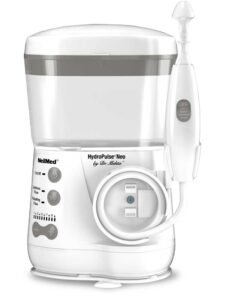Your Temporomandibular Joint
Originally man fought with his jaw and teeth, so it is not surprising that tight jaw muscles are a manifestation of fear, anxiety and aggressiveness. The muscles of the jaw are the ones that are used in anxiety and stress. Your lower jaw (mandible) is connected to the head right in front of your ear. That upper connection is the Temporal Bone. A fairly elaborate set of muscles open your jaw and also closes it. Even when you are not eating, a set movement takes place when you are swallowing or talking or singing. We are built with a system of using our teeth to attack and bite and tear. Much emotion of anger and worry takes place in this system.
Although the dental textbooks all attribute jaw joint disorders to deviations from normal bite anatomy, in practice I see persons with terrible dental structure who don’t have Temporomandibular Joint Disorder (TMJD) and persons who have had the best orthodonture who have this problem. For whatever reason, in TMJD, a patient is manifesting her emotions by clenching her jaw. This kind of patient does well by following the program detailed in Stressed? Anxiety? Your Cure is in the Mirror, page 176.
The symptoms of TMJD are:
Pain on opening the mouth wide
Pain on palpating in front of the ear canal
A noise creptitation that can be felt and heard
Ear Pain
Ear pain after the dentist visit
Pain is referred as a headache, neck pain or facial pain
Relief with anti-inflammatory products such as Clear.ease Lozenges
The jaw opens to the side, indicating that the muscles are not balanced.
Because a primary symptom is ear pain, many patients get put on antibiotics and eardrops. Then, when they are not relieved, a second antibiotic is prescribes. Since it is the jaw joint that is the problem, of course these medications don’t work and even do harm.
Because so many errors in diagnosis are made, it is important that you learn to make your own diagnosis:
Please your finger in front of the ear canal. Feel the movement here as you open and close your mouth. Push into the joint- is that painful? If it is, that’s TMJD. Is there a creaking heard and felt? That too is TMJD.
Now let’s relieve the condition.
With a mirror, draw a straight vertical line down the middle of the mirror. Now line up your forehead and nose along the line. Open the jaw- does it open midline or to the side? Practice relaxing as you exhale and allowing the jaw to come to the side. Practice this daily, emphasis on relaxing so the jaw relaxes to midline. Eventually the muscles get balanced and the jaw opens midline.
In TMJD the joint may be swollen. To reduce that swelling take Clear.ease one four times a day melt in mouth between cheek and gums.
Clear.ease is a lozenge with one million units enzyme of Bromelain from pineapple and 500,000 enzyme units of Papain from Papaya. These are proteolytic enzymes that reduce joint swelling. See www.hydromedonlin.com
X rays of the TMJ don’t give much information except re fracture or displacement. The MRI clearly shows capsule and tendon and ligament abnormalities.
Resting the jaw is help. Use a chinstrap to support the jaw.
If you have a tendency to develop TMJD
a. Avoid wide yawning
b. Be careful laughing not to open jaw too wide
c Avoid chewing gum or pipe smoking
d. Try to make your dental visits as short as possible, break them up into short sessions
e Find an anti-inflammatory product that gives you relief. Clear.ease works for many persons because is is an anti-inflammatory from papaya and pineapple and therefore doesn’t have the gastro-intestinal upsets that most others do.
f. Try sleeping with a chinstrap to hold the jaw from opening too widely.
For more suggestions and procedures, see page 176 of Stressed? Anxiety? Your Cure is in the Mirror.

